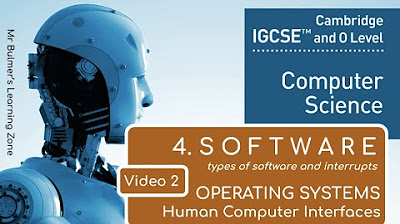How Alexa Works (Probably!) - Computerphile
Summary
TLDRThe video discusses the functionality and challenges of voice interfaces, particularly focusing on Amazon's Alexa. It explores how Alexa processes user commands, like adding items to a shopping list, through automatic speech recognition (ASR) and natural language processing (NLP). The video explains the complexities involved in converting spoken language into actionable tasks, highlighting the dialogue management and text-to-speech generation stages. The discussion also touches on the challenges users face when interacting with Alexa, especially when it misinterprets commands due to ambiguity.
Takeaways
- 🗒️ The video discusses how to interact with voice-activated devices, specifically Amazon Echo using the Alexa service, to manage tasks like creating a shopping list.
- 🔍 It explains that voice commands are first picked up by the device's automatic speech recognition (ASR), which detects the wake word 'Alexa' and sends the rest of the command to the cloud for further processing.
- 💬 The script highlights the importance of natural language processing (NLP) and natural language understanding in breaking down and making sense of the user's commands.
- 📝 The dialogue manager plays a crucial role in interpreting the parsed commands and generating an appropriate response, considering the context of the conversation.
- 🔄 The video mentions that the device may draw on various resources, such as Amazon services for a shopping list, to retrieve or store information.
- 📈 The process involves a complex cycle of speech recognition, text parsing, dialogue management, and text-to-speech conversion to provide a response to the user.
- 🤖 The script points out the potential for misunderstanding due to ambiguity in language, such as interpreting 'computer file' as two separate words instead of one.
- 🔊 The video script also touches on the technical aspects of speech generation, emphasizing the sophistication and complexity behind text-to-speech technology.
- 📱 The discussion includes the user experience aspect, noting that people using voice devices need to find ways to talk about them without accidentally triggering the device.
- 🛒 An example is given of how to ask Alexa about the contents of a shopping list, demonstrating the interaction process from command to response.
- 🔍 The video also hints at the ongoing improvements and updates in voice recognition and text-to-speech technologies to enhance user experience and accuracy.
Q & A
What is the main purpose of a shopping list according to the script?
-The main purpose of a shopping list is to identify and keep track of items needed for purchase, such as dish soap or shampoo.
How does the script describe the process of adding something to a shopping list using Alexa?
-The script does not provide a direct method for adding items to a shopping list using Alexa, but it implies that one would need to interact with Alexa through voice commands to manage the shopping list.
What is the role of Automatic Speech Recognition (ASR) in voice interfaces like Alexa?
-ASR plays a crucial role in detecting the wake word 'Alexa' and transcribing the rest of the user's spoken command into text for further processing.
What does the script suggest about the complexity of Natural Language Processing (NLP) in voice interfaces?
-The script suggests that NLP is complex and involves breaking down text into meaningful components that the system can understand and act upon, such as identifying commands and relevant information.
How does the script explain the ambiguity in voice commands that can be misunderstood by Alexa?
-The script provides an example where the phrase 'computer file' is misunderstood as two separate words 'computer' and 'file', demonstrating how context and word grouping can affect understanding.
What is the function of a dialogue manager in voice interfaces?
-A dialogue manager takes the parsed components of a user's command and determines the appropriate response, considering the context of the conversation and potentially accessing other resources or services.
Why is the text-to-speech process important in voice interfaces?
-The text-to-speech process is important because it allows the device to generate audible responses based on the text output from the dialogue manager, making the information accessible to the user.
What does the script imply about the need for data and computing power in ASR systems?
-The script implies that ASR systems require a significant amount of data and computing power to effectively learn and process the input audio to produce accurate text outputs.
How does the script address the issue of conversational flow in voice interfaces?
-The script mentions that the dialogue manager considers the conversational state and flow, which may involve asking clarifying questions or providing information based on the current context of the interaction.
What is the significance of the wake word in voice-activated devices like Alexa?
-The wake word 'Alexa' is significant because it triggers the device to start listening and processing the user's command, initiating the interaction.
Outlines

This section is available to paid users only. Please upgrade to access this part.
Upgrade NowMindmap

This section is available to paid users only. Please upgrade to access this part.
Upgrade NowKeywords

This section is available to paid users only. Please upgrade to access this part.
Upgrade NowHighlights

This section is available to paid users only. Please upgrade to access this part.
Upgrade NowTranscripts

This section is available to paid users only. Please upgrade to access this part.
Upgrade NowBrowse More Related Video

Prime Day protests: Amazon workers fight for better working conditions and pay

Tech Subscriptions Are Out of Control

🚨We Caught Amazon Red-Handed RIGGING The 2024 Election AGAINST Trump | This Is INSANE…

WWDC 2024: What to Expect from Apple’s Big Event

IGCSE Computer Science 2023-25 - SOFTWARE: Video 2 - THE OPERATING SYSTEM

Kamala Harris Slammed for 'Fake Accent' in Detroit Speech and more news!
5.0 / 5 (0 votes)